
One of the altars to Her Royal Highness Princess Bejaratana Rajasuda in the northern
half of Sanam Luang; here Thai people could offer sandalwood flowers as a token of respect.
From Koh Tao, I hopped on the Songserm Express boat for the three-hour ride northwest to Chumphon town on the mainland, then got on a bus that evening for Bangkok. The bus arrived two hours early, but at an inconvenient 3 a.m., Sunday morning, then I went in search of a room. Several guesthouses were full, surprising since April is notorious for being the hottest month of the year. One guesthouse had overpriced shoebox-sized rooms and a hotel insisted on a check-out time just hours away, then I found a slightly run-down room in the Green Guesthouse, which had welcome air-conditioning, free wi-fi, and I could stay until tomorrow noon. After a power nap, I headed by river express boat and SkyTrain to a talk at the World Buddhist University by David Holmes, a Buddhist scholar and retired university lecturer. He has a very gentle demeanor and gave a talk about essential teachings of the Buddha. If you are interested in exploring Buddhism, you can drop by his website www.noblepath.info/ or see his illustrated postings with bits of wisdom at www.facebook.com/idavedale.
The next day I experienced an unusual aspect of Thai culture—a royal funeral. Her Royal Highness Princess Bejaratana Rajasuda, the only child of King Rama VI (ruled 1910-25), had died last July at age 85. More than 8 months had been required for planning the elaborate royal cremation ceremony and constructing a group of temporary buildings on Sanam Luang, just north of the Temple of Emerald Buddha and old Royal Palace. I walked down with my Thai friend Chainat in the late afternoon, and we observed the proceedings from a distance. Large-screen televisions gave us a view of the rituals that took place inside the buildings. The king, queen, crown prince, and princesses took part in the lengthy ceremony inside a large pavilion, where senior monks chanted. Musicians and singers performed melancholy traditional Thai music. Senior government officials filed through to pay their last respects, the men dressed in formal white uniforms with a black arm band and the women wearing all black dresses. Cannons fired by artillery regiment officers sounded periodically during the day.

One of the altars to Her Royal Highness Princess Bejaratana Rajasuda in the
northern
half of Sanam Luang; here Thai people could offer sandalwood flowers as a token
of respect.

This is the place where the public could watch the cremation ceremony. A
symbolic cremation attended by the king is taking place now, in late afternoon.
The actual royal cremation will take place beginning about 10 p.m. in the
multi-tiered building on the center right; the multi-tiered roof symbolizes
Mount Meru of
Hindu mythology. Two buildings of the Temple of the Emerald Buddha complex are
on the far right in the distance.

White-uniformed government officials stand between the cremation hall (out of
sight to the left) and the large pavilion on the right
where the royal family
performs its role in the ceremony. In the distance you can see the Temple of the
Emerald Buddha complex.
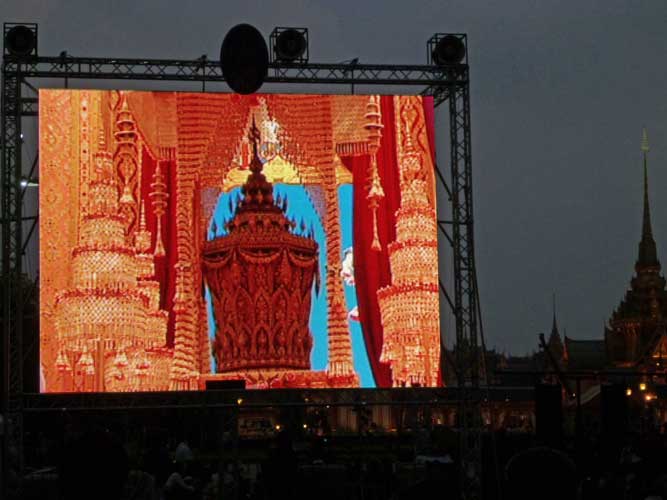
A giant television screen shows the royal urn that holds the princess. It's
inside the cremation building, which is visible on the far right.

The scene becomes even more magical after dark! You can see most of the funerary
structures
in this view, as well as golden spires of the Temple of the Emerald
Buddha complex in the distance.

A white royal "umbrella" tops the cremation building on the left.
As darkness fell, Chainat and I crossed the street to the National Theatre where dancers were getting masks and costumes ready for cultural performances that would last until dawn. Three large stages in the public area of Sanam Luang were to host Thai music and dance programs beginning at 7 p.m., just after dark. Unfortunately, massive thunderstorms that had been rumbling overhead finally let loose just as the performances were about to start. The downpour forced Chainat and myself to retreat back to my guesthouse. After drying out a bit, we found that the rains had stopped, so we returned to the performance stages at Sanam Luang. One hosted Thai popular songs that to my ears sounded slow and ponderous. Another stage hosted a series of dances that portrayed Thai legends. The third stage held a huge cast of masked dancers depicting scenes from the Thai version of the great Hindu epic, the Ramayana; traditional Thai orchestras played on both sides of the stage. Although the rain held off, standing on very soggy grass was uncomfortable and my friend Chainat's feet became very wet, so he returned to the guesthouse. I stayed on awhile longer.
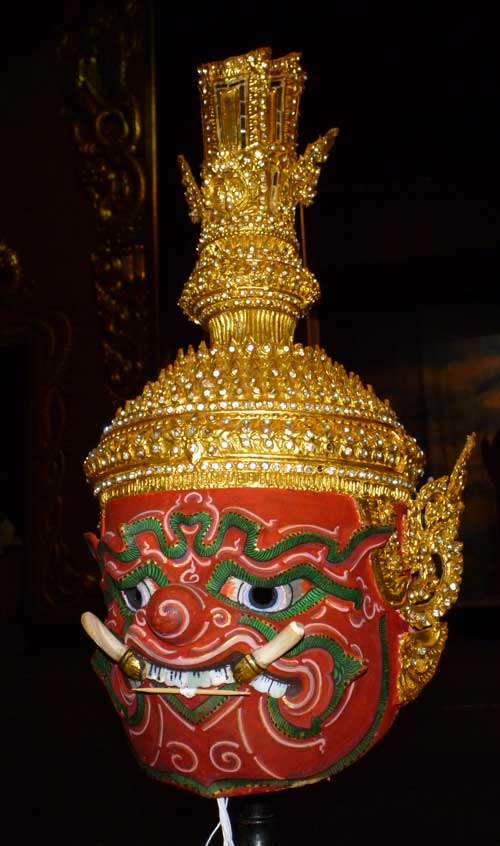
A demon mask waits inside the National Theatre.

A band from Chulalongkorn University plays rather ponderous accompaniment for
singers, who are out of sight to the left.
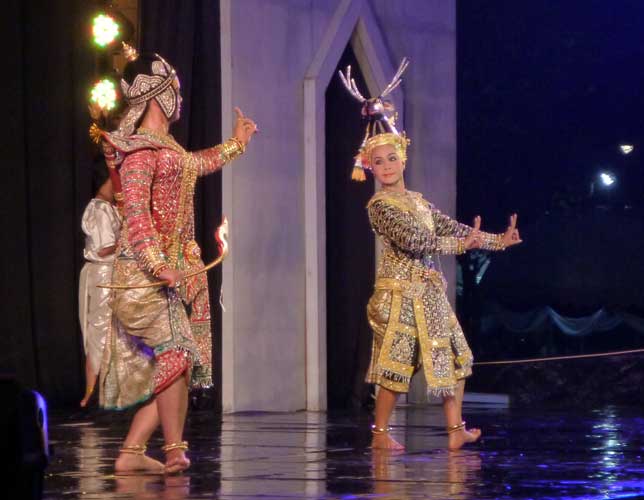
A "hunter" pursues a very pretty "deer" in this depiction
of a traditional Thai story.

A demon general with his troops in a performance of the Ramayana. You can see
singers and musicians on the left end of the stage.
At 10 p.m. the performances stopped for an hour. The king returned and led a ceremonial lighting of the funeral pyre by casting a burning piece of sandalwood toward the base of the urn. Other members of the royal family then did the same in turn. I had wondered if the whole cremation building would be going up in flames, but my friend assured me that wouldn't happen. Nor would the highly ornate funerary urn be burned; it was too artistically valuable. Instead, the cremation took place in an electric crematorium in the east wing of the building. The king soon left as he was in poor health and very frail, but the crown prince and other royals stayed for a performance of traditional Khon (masked) drama in front of the cremation building. I didn't see any smoke or other sign that the cremation was taking place. About 11 p.m. the performances on the three stages in the public area restarted, but with no place to sit down amongst the puddles, I soon felt tired and wandered back to the guesthouse. I wished that the performances had been held indoors at the nearby National Theatre, but perhaps the planners thought that venue would be too small for the expected large crowds.
The royal cremation concluded the next day with a ceremony of collecting the relics and a procession to bring them to the old royal palace where they were enshrined, I got to see some of this on television. Early in the morning, my friend Chainat and I walked north through back lanes to a temple where he had lived as a schoolboy; here he had helped out in return for food and a place to stay. We said goodbye near the Thewet express boat stop and he cycled home. I got on the next boat for a ride downriver to the Sathorn stop where I connected with the SkyTrain to head over to the Sukhumvit area, packed with foreigners and upscale hotels and restaurants. Here I met travel writer Michael Buckley for a chat over a big and scrumptious breakfast buffet in the Sheraton Grande Sukhumvit. Michael is on the road much of the time in Asia researching new stories, so it was fortunate that we both happened to be in Bangkok. We got a window table above hectic Sukhumvit Road and enjoyed multiple plates of wonderful delicacies. In the afternoon I swung by the Bangkok Art & Cultural Centre, an intriguing nine-story tower full of contemporary art exhibits and galleries; I spent most of my time in a large and varied exhibit by Chiang Mai artists of northern Thailand. The day ended with a sunset ride back up the Chao Phraya River, then a stroll through Santichaiprakarn Park, where a Thai pop music concert was underway and the adjacent Phra Sumen Fort had dramatic nighttime lighting.
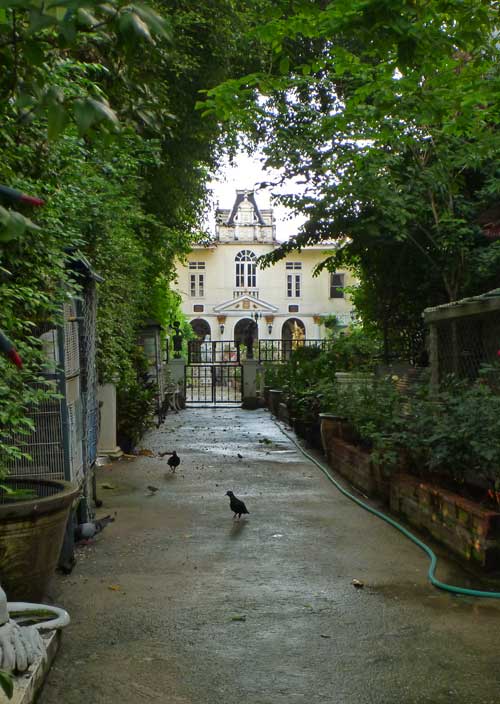
I usually stay in the New Merry V Guesthouse on Phra Athit Road, an area once
popular with the noblemen of Bangkok.
The noblemen chose this area because it
was close to the Chao Phraya River and canals, the main transport in the old
days,
as well as convenient to the old royal palace. I think all the princes now live
elsewhere, and their mansions have become
homes to nongovernmental
organizations. This is one of the old palaces, visible down a garden lane.

One of the many glittering temples of old Bangkok.
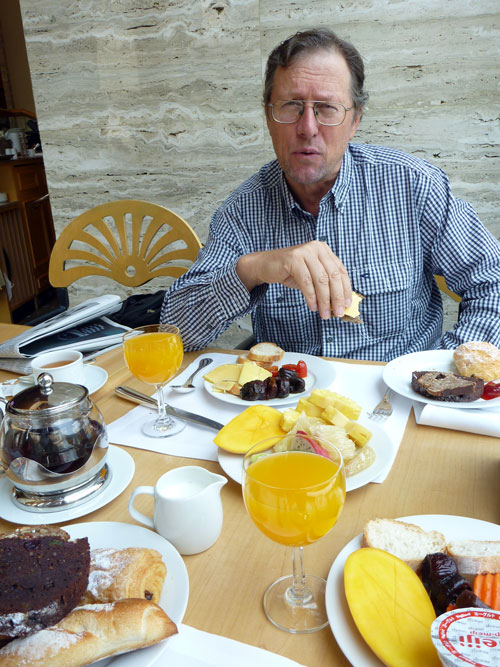
Fellow travel guidebook author Michael Buckley was in town, and we splashed out
for the breakfast buffet at the upscale Sheraton Grande Sukhumvit hotel.
The
buffet had an incredible variety of top-notch food. Michael is from Canada and
now travels extensively around
Asia pursuing writing and video documentary
projects, which you can read about at his website
www.himmies.com.
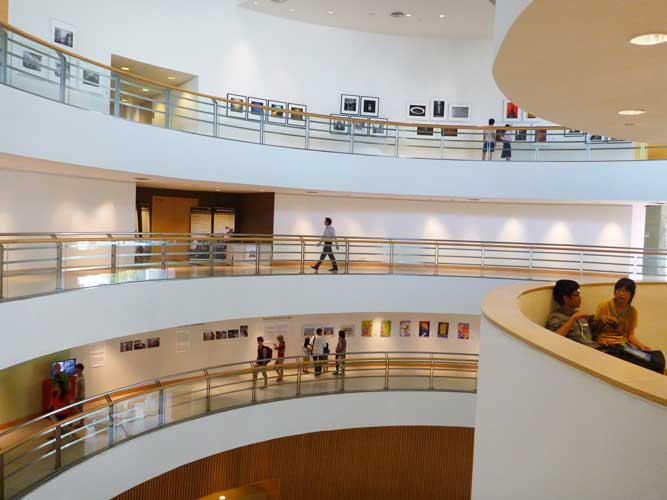
Bangkok Arts & Cultural Center has nine levels, most encircling this vast
atrium. It's a great place to see contemporary
art and perhaps catch a play, movie, or music concert.
The central location is
just off the SkyTrain National Stadium station;
closed on Mondays.
See
https://en.bacc.or.th/ for
current and upcoming exhibits and performances. Admission is free!
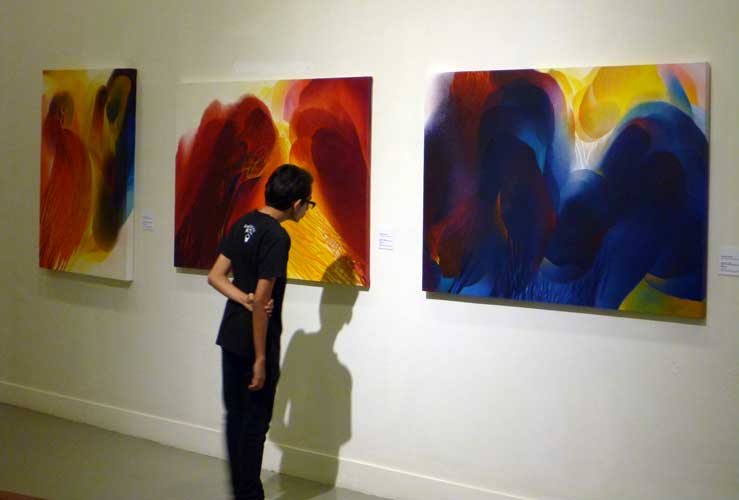
Part of a large and varied exhibit by artists from Chiang Mai at Bangkok Art &
Cultural Centre
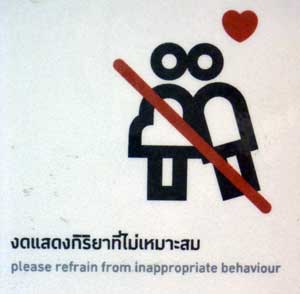
I don't usually take photos in restrooms, but this little sign in the Bangkok
Art & Cultural Centre
was just too funny! Thais become uncomfortable when couples kiss or snuggle up
close in public.

A boat ride on the Chao Phraya River passes many memorable buildings of old and
new Bangkok. By taking the express boat and
connecting with the SkyTrain or underground Metro, I can reach most places in
central Bangkok while enjoying scenic views all the way. Here four barges are
being towed downriver; each has a little "house" on the stern for the barge men
and their families.
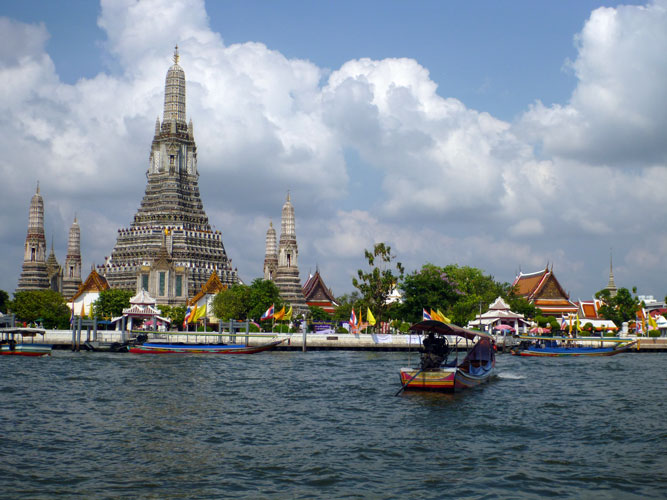
Wat Arun, or Temple of Dawn, towers above the Chao Phraya River.

Sunset and skyscrapers along the Chao Phraya River reflect in the CAT
(Communications Authority of Thailand) building.
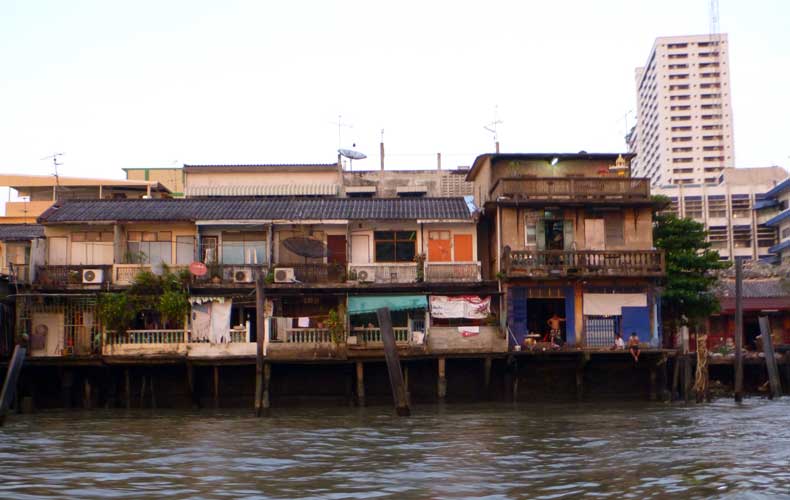
Old houses cling to the banks of the Chao Phraya River.
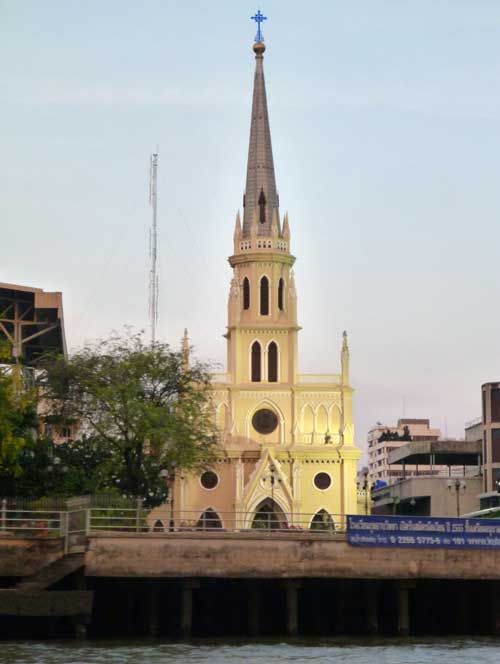
The Portuguese built Holy Rosary Church in 1786 with a land grant from King Rama
I, just four years after
Bangkok was established as the capital. You'll see buildings from all of
Thailand's religions along the Chao Phraya River.

Sunset—heading home on the Chao Phraya River
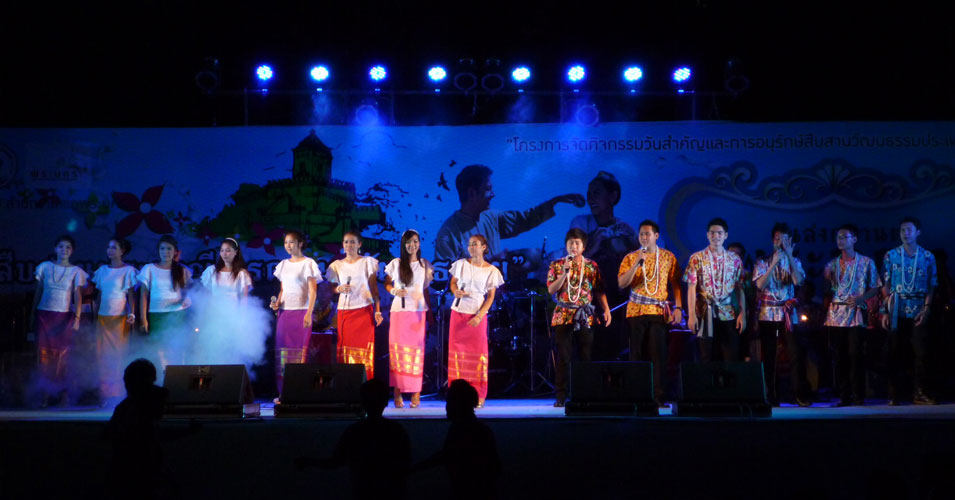
Free concert of Thai popular music on a temporary stage set up in
Santichaiprakarn Park along Phra Athit Road
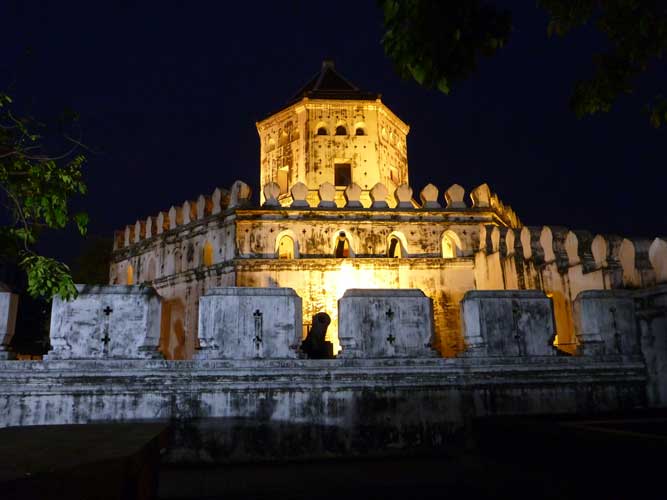
Phra Sumen Fort once guarded the confluence of the Chao Phraya River and
Banglamphu Canal, near the north end
of Phra Athit Road. The octagonal structure is made of bricks coated in cement
and dates from the reign of King Rama I.
Of the 14 forts built in Bangkok under his reign, only this and one other
survive.